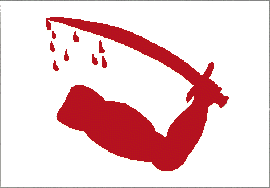
Dimmit's Bloody Arm Flag

Dimmit's Bloody Arm Flag
There is some indication that Dimmit may have left his original 1824 flag in Bexar and that when Dr. James Grant stripped the Alamo of provisions and left Bexar on January 1, 1836, he took the flag with him. Grant, though a citizen of Coahuila, was one of the few Texian leaders who continued to fight for Restoration. Grant held large land holdings in Coahuila and the only way he could keep these large estates was for the 1824 Constitution to be restored. If either Santa Anna won the war or the Texians won independence from Mexico, his very large land holdings in Coahuila would be lost forever. The only way he could keep his land would be for Santa Anna to be deposed and the Constitution of 1824 to be reinstated. To this end he stripped the Alamo of all provisions and mounted an expedition to Matamoros in an abortive attempt to link up with and rally Mexican Federalist forces there. On January 10, 1836, Col. F.W. Johnson, who helped lead the Matamoros Expedition, issued a proclamation which said in part:
"Under sanction of the general council of, they (the Federal Volunteer army of Texas) have taken up the line of march for the country west of the Rio Grande. They march under the flag 1.8.2.4, as proclaimed by the government of Texas, and have for their object the restoration of the principles of the constitution, and the extermination of the last vestige of despotism from Mexican soil..."Apparently, Johnson appropriated the 1824 Flag from the privateers, placed it at the head of his volunteers and attributed the action to the General Council. The General Council never santioned the flag for anything except Letters of Marque and Reprisal. This detail does not seem to have been noticed either by Johnson or a great many other people since that time.The Matamoros Expedition made it as far as San Patricio where on February 27 General Urréa, of the Mexican Army, and his men captured or killed most of the expedition members. Johnson and three others managed to escape the Mexican's attack. Johnson, disgusted with the personalities and politics of the revolution, retired from the army and later wrote a history of Texas. When the Mexicans attacked San Patricio, Grant was away hunting horses and when the Mexicans caught up with him on March 2 he was killed at the Battle of Agua Dulce Crossing.
It is ironic that on the very same day, March 2, 1836, both reasons for the 1824 Flag died. Dr. James Grant, the only man in Texas still fighting for the restoration of the Constitution of 1824, was killed at Agua Dulce Crossing and the Texian convention at Washington-on-the-Brazos passed the Texas Declaration of Independence.
The question still remains, however, "Did the 1824 Flag fly during the Battle of the Alamo?" Probably not, but that is a story for the next chapter.